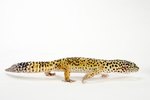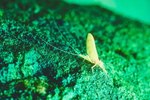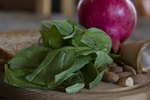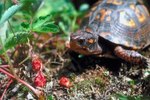
All reptiles can be distinguished by several characteristics; they are cold-blooded, they are scaled and they reproduce via laying eggs. Not all reptiles have the same temperament, habitat or diet, however, despite similarities in taxonomy. While many reptiles such as lizards and snakes are carnivorous, there are reptiles that exist solely on a vegetarian, or herbivorous, diet.
Tortoises

The tortoise is a diurnal, reclusive reptile that can live to be well over a hundred years of age. The tortoise's herbivorous diet is comprised entirely of local grasses, weeds, flowers, leafy greens and some fruit. Hays and grasses eaten by land tortoises include timothy hay, Bermuda grass, wheat grass and yard grass. Alfalfa hay can be eaten by tortoises, but only in small amounts, as it is high in proteins. Too much protein can cause shell deformities in growing tortoises.
Iguana

Iguanas are very strict herbivores and cannot easily process the fats and intense proteins found in animal fats and tissue. An iguana's diet consists primarily of leafy greens and flowers, with added vegetables such as green beans and orange-fleshed squashes. Fruit and grains can make up a small portion of the iguana's diet, but these should be reserved for treats. Iguanas have a digestive system that efficiently extracts protein and nutrients from green leaves, and do not require additional supplementation in their diets.
Chuckwalla

Measuring up to 30 inches in length, the chuckwallas of the American southwest are one of the largest living lizards. These stocky, wide-bodied cousins of the iguana prefer to live on rocky terrain, and despite their size are harmless to humans and smaller animals. Chuckwallas feast upon leaves and fruit, but primarily the flowers of perennials and annuals in their habitat. In captivity, the chuckwalla will devour any kind of fruit or vegetation, ranging from radish tops to various melons.
Uromastyx

The uromastyx, also known as the spiny-tailed lizard, is a stout, spike-tailed lizard found in the Middle East and Asia. In the wild, the uromastyx will eat coarse desert grasses, gourds and wild squash and vegetation from various bushes and brush. Local flowers such as acacia and hibiscus are a part of the uromastyx's natural diet. Unfortunately, acacia is routinely harvested to make charcoal by native humans to the areas. This has depleted some of the uromastyx's food resources and habitat.
References
- Reptiles and Herbivory; G. M. King
- Medicine and Surgery of Tortoises and Turtles; Stuart McArthur, Roger Wilkinson, Jean Meyer
- Green Iguana Society: Feeding Iguanas
- Physiological Zoology, Volume 57: Structure and Function of the Digestive Tract of a Herbivorous Lizard Iguana Iguana; Katherine Troyer
- Handbook of Lizards: Lizards of the United States and of Canada; Hobart M. Smith
- Uromastyx; John F. Taylor
Resources
Photo Credits
-
Thinkstock/Comstock/Getty Images




